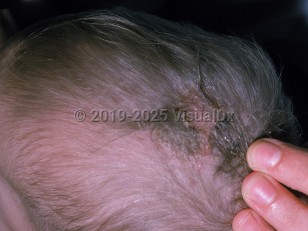Hyperimmunoglobulinemia E syndrome in Infant/Neonate
Alerts and Notices
Important News & Links
Synopsis

Hyperimmunoglobulinemia E syndrome (hyper-IgE syndrome) represents a group of multisystem immunodeficiency disorders characterized by atopic dermatitis, recurrent cutaneous and systemic (usually pulmonary) infections, and variably high levels of IgE. Signal transducer and activator of transcription-3 (STAT3) mutations are associated with the classic form termed Job syndrome. However, mutations in IL6R, ERBB21P, CARD11, DOCK8, PGM3, and ZNF431 can cause a similar clinical phenotype. Facial dysmorphism and skeletal, dental, and connective tissue anomalies are additional findings. Autosomal dominant and autosomal recessive forms occur, and the underlying genotypes also confer unique clinical variation. For example, patients with DOCK8 mutations have a high susceptibility to severe mucocutaneous viral infections, mucocutaneous candidiasis, and squamous cell carcinoma (SCC). Patients with PGM3 deficiency have neurologic abnormalities and may present with leukocytoclastic vasculitis (LCV) in addition to viral and candidal infections. Patients with ZNF431 mutations phenotypically resemble autosomal dominant hyper-IgE syndrome.
The "cold abscesses" in autosomal dominant hyper-IgE syndrome (Job syndrome) occur due to impaired IL-6 transduction and PGE2 release in the brain. This is not a usual feature in DOCK8 deficiency, where low IgM levels may be identified.
Patients with CARD11 mutations resemble those with DOCK8 mutations; however, incidence of viral infections and malignancy is lower and severe cases of molluscum contagiosum occur. Autoimmune colitis, primary ovarian failure, T-cell lymphoma, and lichen planus have been associated with the CARD11 mutations.
Pathogens associated with the infections include Staphylococcus aureus, most frequently, followed by Haemophilus influenzae, Streptococcus pyogenes, Escherichia coli, Pseudomonas, and Candida albicans. There is impaired chemotaxis in neutrophils, and retention of primary dentition may occur due to STAT-3's influence on IL-11, a necessary factor for dental exfoliation.
There is a National Institutes of Health (NIH) scoring system to assist in making this diagnosis. Scores greater than 40 on this scale indicate a high probability of the diagnosis.
The "cold abscesses" in autosomal dominant hyper-IgE syndrome (Job syndrome) occur due to impaired IL-6 transduction and PGE2 release in the brain. This is not a usual feature in DOCK8 deficiency, where low IgM levels may be identified.
Patients with CARD11 mutations resemble those with DOCK8 mutations; however, incidence of viral infections and malignancy is lower and severe cases of molluscum contagiosum occur. Autoimmune colitis, primary ovarian failure, T-cell lymphoma, and lichen planus have been associated with the CARD11 mutations.
Pathogens associated with the infections include Staphylococcus aureus, most frequently, followed by Haemophilus influenzae, Streptococcus pyogenes, Escherichia coli, Pseudomonas, and Candida albicans. There is impaired chemotaxis in neutrophils, and retention of primary dentition may occur due to STAT-3's influence on IL-11, a necessary factor for dental exfoliation.
There is a National Institutes of Health (NIH) scoring system to assist in making this diagnosis. Scores greater than 40 on this scale indicate a high probability of the diagnosis.
Codes
ICD10CM:
D82.4 – Hyperimmunoglobulin E [IgE] syndrome
SNOMEDCT:
50926003 – Hyperimmunoglobulin E syndrome
D82.4 – Hyperimmunoglobulin E [IgE] syndrome
SNOMEDCT:
50926003 – Hyperimmunoglobulin E syndrome
Look For
Subscription Required
Diagnostic Pearls
Subscription Required
Differential Diagnosis & Pitfalls

To perform a comparison, select diagnoses from the classic differential
Subscription Required
Best Tests
Subscription Required
Management Pearls
Subscription Required
Therapy
Subscription Required
References
Subscription Required
Last Reviewed:06/29/2022
Last Updated:07/07/2022
Last Updated:07/07/2022
Hyperimmunoglobulinemia E syndrome in Infant/Neonate

